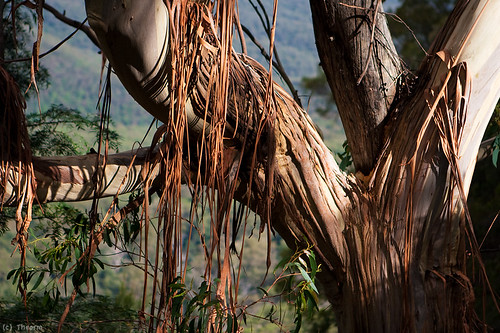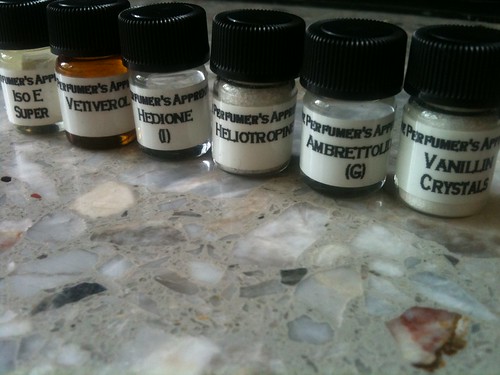My olfactory adventures did not, by any means, end when leaving San Francisco. On July 2nd, my friend D and I drove to Santa Cruz, and we were hoping to stop at The Perfumer's Apprentice to explore some synthetic molecules and say hello to Linda, who for one holiday season a few years ago carried my Palas Atena and Fête d'Hiver perfumes.
While en route, we discovered that the shop in Santa Cruz has shut down, and the premises moved to Felton, which was just on our way there anyway. We rang Linda up and were glad to get a hold of her just as we arrived at Felton!
The Perfumer's Apprentice is now mostly operated as an online shop; but it is open by appointment-only for private perfume-making parties at Linda's garden, which is shaded by ancient oak trees and inhabited by friendly honeybees. We were lucky enough to be received for such a spontaneous, short-notice visit, and be allowed into The Perfumer's Apprentice's warehouse, which housed hundreds of bottles, vials and jars containing both natural extracts and synthetic molecules, as well as flavouring agents and fragrance oils.
I have to admit that being exposed to so many aromatics all at once, even in the well-ventilated space where they are stores, was nothing short than nose-boggling overwhelmence. Often when I'm asked why I decided to be a natural perfumer, I say that it's for complete selfish reasons - I prefer to be surrounded by the mellow, well-rounded naturals than the often harsh, extremely potent and articulate synthetic molecules.
With that being said, even a spoiled nose such as mine has to train itself to embrace the foul as well as the fragrant. And I've set myself a goal this year to study as many as possible of the natural constituents that make up the beautiful, rich and complex essential oils and absolutes I work with every day. Again, for completely selfish reasons - I feel it's important to educate my nose, and be knowledgeable and open minded about synthetics, even if I choose not to work with them or include them in my perfumes.
While some of the constituents are readily available as isolates, others are not so easy to find. So I'm now in the process of collecting small samples of natural constituents (i.e.: naturally occuring aromachemicals in their purest form - i.e.: not within a complex essential oil "compound") so that I can educate my nose and deepen my understanding of the essences I know so intimately from my 10 years of working with them.
And what better place than The Perfumer's Apprentice? It is a heaven for any perfume afficinado that wants to meddle in the art of perfumery, or simply satisfy their curiosity regarding the raw materials widely used in modern perfumery and find out how Iso E Super (overdosed in the popular Eccentric Molecule), Ethyl Maltol (the main molecule in Angel) or Galaxolide (that evil polycyclic musk that pervades all laundry detergents and dryer sheets and pollutes our water supplies as it never breaks down), or are curious to find out what indole (the main constituent in civet, and what gives jasmine it's extra animalic/fecal oomph) smells like - to name but a few examples.
Unfortunately, I left my shopping list on my laptop back in Sonoma county, so my choices were all based on my memory and a few labels that I caught glimpses of while browsing the overwhelmingly fragrant shelves. I picked up a few natural constituents (lab-made synthetics that are naturally occurring), and a few man-made molecules (i.e.: not naturally occurring - aromatics that were entirely made up by creative and/or lucky chemists in the lab). One of the latter ones is Calone, which was accidentally discovered by the pharmaceutical company Pfizer in 1951, only to find its (popular) use in perfumery some 40 years later in the late 80's and early 90's, with the aquatic genre of Cool Water, l'Eau d'Issey, Dune, Escape and the like.
And, of course, I HAD to get some Hedione - the beautiful, synthetic molecule that closely resembles an element in jasmine (that gives it its dewy, green, fresh and expansive quality). It is so mellow comparing to all the other potently vile aldehydes, calone etc. that I will have to dedicate a post for it at a later time to give it the attention it deserves (it's this synthetic raw material that makes favourites such as Le Parfum de Therese and Eau Sauvage so beautiful).
I also got
Spirogalbanone, an intensely green synthetic lactone, that I wish I had quarantined right away (should have done the same with the aldehydes - they are terribly potent when not individually ziploced and separated from the rest of the crowd...! It smells very much like the sharp, disturbing green opening of galbanum, amplified by 1,000. Not for the faint of heart!
Other than these, most of the materials I've picked were naturally-occuring molecules, but syntheticlaly made - for example: I got a few aldhydes, including
C-14 (peach), and C-11 which accounts for the scalp-like, oily-fatty accents in No. 5 that made it so special at the time and smell like a woman, not like a flower... The aldehydes must be diluted down to be of any use. They are traditionally diluted down to as low as 1% (where most materials are diluted down to 10% to study their characteristics). Try to experience them at full strength and prepare to gag.
Among the beauties were Ambroxan (naturally occurring in ambergris, and has excellent stable and fixative qualities and sort of a warm, musky scent), Ambrettolide, which naturally occurs in ambrette seed, and has a clean, what we learn to call "white musk". Also have some raspberry ketone, vanillin, heliotropin, all in crystals so will have to dilute in alcohol to really be able to smell (rather than snort!) them.
And last but not least - Vetiverol - vetiver alcohol - which is what gives vetiver its clean, precious-wood, slightly wet yet sweet aroma. I have a suspicion there is more of it in Haitian vetiver than other varieties. It also has a brown clear colour, which makes it look like vetiver oil, where as most of the synthetics are either transparent and clear or white crystals. Vetiverol is so rich and complex it's surprising that it's "only" one molecule.
I'm looking forward to discovering these building blocks (especially the naturally-occurring ones) as well as the isolates I've gotten from Aftelier. It will be interesting to work with natural isolates in perfumes, but I strongly feel like I found my voice in natural perfumery sans the pure isolates. Nevertheless, I'm curious to study them, and am fascinated by the chemistry of the oils I work with. Exploring organic chemistry is like learning a new language, which I find exciting and frighteningly intimidating, simultaneously.




